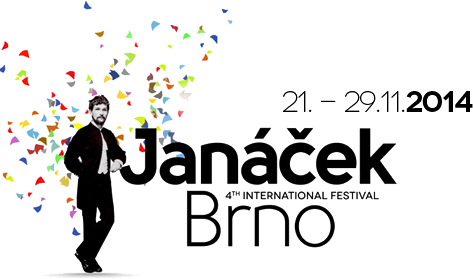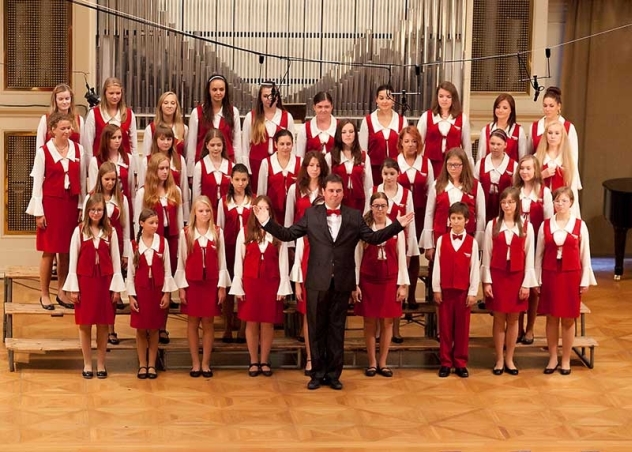BOHUSLAV MARTINŮ (1890–1959)
Primrose H 348
A New Hat
Behind Our Farmyard
Complaint
Painted Wood
Midday
JOSEF BOHUSLAV FOERSTER (1859–1951)
Children’s Choruses op. 89
Forest Spring
Crocodile
Nut
KAREL REINER (1910–1979)
The Flowered Horse (selection from the cycle)
It begins with Adam
Potatoes and barometers
Ten commandments for young poets
The electric spell
The photographer
Goliath was a terrible master
The flowered horse
Brno Children’s Chorus
Valeria Maťašová – choirmaster
Pavel Wallinger – violin
Šárka Králová – piano
LEOŠ JANÁČEK (1854–1928)
Little Queens
We are carrying the maypole
The falcon flew away
We have a lame queen
Hurry, my little queen, hurry
Who is the queen that the king has gained
Little onion
The gallant’s young wife
We’re riding to the mill
A beautiful, beautiful little queen is standing
Our queen
Our willows are turning green
LEOŠ JANÁČEK (1854–1928)
Nursery Rhymes
Turnip was getting married
Nothing’s nicer than early spring
Mole is crawling
Karel rode to hell
Torn trousers
Franta from the knacker family plays the bass
Our dog, our dog
I’m preaching a sermon
The old woman was casting spells
Ho, ho, the cows are coming
My tiny little wife
The old woman’s crawling into the elder tree
The white goat’s picking pears
The surly German banged the pots
The goat lies on the hay
Vašek, shepherd boy, drummer-boy
Frantík, Frantík
The bear sat on the tree trunk
Kantiléna, the Youth and Children’s Choir at the Brno Philharmonic
Jakub Klecker – Choirmaster
Petr Pomkla – 1st flute, Kristina Vaculová – 2nd flute, Lukáš Daňhel – 1st clarinet, Stanislav Pavlíček – 2nd clarinet, Dušan Drápela – 1st bassoon, Jiří Jakubec – 2nd bassoon and contrabassoon, Michal Pokorný – double bass, Petr Hladík – ocarina and small drum, Jiří Hrubý –piano
Petr Levíček – tenor
Jan Šťáva – bass
Choral works have been important for a number of Czech composers. Bohuslav Martinů (1890–1959) wrote dozens of songs and choruses, and in most of them he took his inspiration from folk poetry – for example, the New Chap-Book from 1942 or Sušil’s magical collection Songs on One Page and Songs on Two Pages from 1943 and 1944, which despite their diminutive size impress with their harmonic and rhythmic charge. In Nice in 1954 Martinů composed another popular chorus based on Moravian folk poetry, stylized as duets for soprano, alto, violin and piano, called Primrose. The impetus for these duets came from the composer and conductor Zdeňek Zouhar, who performed this opus with his female choir in 1955. It is well known that when Martinů was invited to write these choruses by Zouhar, he spontaneously replied: “I would be delighted to write some duets for you… Working with our folk texts always brings me pleasure”. Today Primrose is one of the jewels of the Czech choral repertoire, and it is also interesting that it forms a kind of counterweight to the composer’s monophonic songs and also a new variation on Dvořák’s Moravian Duets.
The songs and especially the choruses of Josef Bohuslav Foerster (1859–1951) are some of his most popular works. He inherited his love of choral song from his ancestors and he began his musical life as a choral singer (choir of the church of St Adalbert, Prague Hlahol). In his own choral works he initially borrowed greatly from Smetana and Dvořák, but as he continued to mature in his composition he was influenced by other developments and he set off in several directions – for example, using extreme positions (falsetto), wide dynamic contrasts and hitherto unknown inner dramatic tension, which left its imprint on every larger-scale choral creation. The choruses presented today are part of a five-part collection entitled Children’s Choruses op. 89. The accompanying texts were written by Josef Václav Sládek and Karel Toman.
Because of his Jewish origin and the times in which he lived, the life of the composer Karel Reiner (1910–1979) was far from easy… He wrote more than 280 smaller and larger, mainly instrumental pieces. A large part of his work was made up of incidental music for films, theatre and radio. At the same time he worked in musical education and journalism. He also has several choruses to his name, among which the foremost is the cycle The Flowered Horse – poems, games and rhymes to the words of Norbert Frýd from 1942.
There is a significant proportion of choral compositions among the work of Leoš Janáček (1854–1928). He himself was the choirmaster of several amateur choirs, but in the years 1879-88, for example, also of the Brno Beseda, where he attracted attention as an excellent and lively conductor. There he followed the footsteps of Křížkovský and led the society’s choir to great musical heights.
Choruses were the first of Janáček’s works on which he honed his compositional style. Among his most famous male choruses are Maryčka Magdónova, 70.000, and Halfar the schoolmaster from the start of the 20th century. Janáček wrote the cycle Little Queens with the subtitle Old Ritual Folk Dances with Songs in 1889 and it is made up of 10 folk songs and dances. Little Queens comes from a period when Leoš Janáček systematically and consciously drew on folk song, dance and poetry. Little Queens has its origin in the pagan era and is related to the summer solstice. These are ancient ceremonial dances with songs which were collected and compiled by František X. Bakeš in the late 19th century on the basis of work by the renowned collector František Sušil.
Janáček composed the Nursery Rhymes in 1925, originally for three mezzo-sopranos, clarinet and piano, and set only eight nursery rhymes to music. In 1926 the work was expanded into the form we know today. The cycle was created in 1926 to short verses for children which were published in the children’s supplement of the Lidové noviny newspaper and are among the greatest works from the Maestro’s last period. Janáček wanted to project some of Lada’s illustrations to go along with the Nursery Rhymes, but it was technically impossible at the time. It was not until the end of the 1940s that the director Eduard Hofman was able to animate Lada’s illustrations. However, he only worked on a selection of the Nursery Rhymes, so for the remaining parts the film was supplemented by static images
Pavel Petráněk







